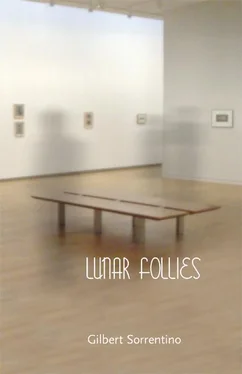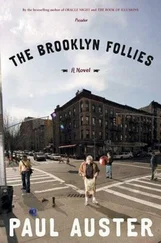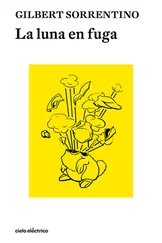A number of large television sets — seven, to be precise — show, continuously, the same film, variously titled The Past, Rock Island Rock, or Celebrity Toodle-oo . Each is played, if that’s the word, at a different speed, if that’s the word, so that the imagery, as well as the narrative, such as it is, in each film is identical, the differing speeds at which this imagery and narrative are deployed, if that’s the word, enforcing the sense or idea that the viewer, the ideal viewer, is being presented with seven different films. This is posolutely correct, a construction facilitator notes, using a whimsical coinage, if that’s the word, said to be invented by Joe Penner or Ed Wynn on the old vaudeville circuit. They, and others, often played the Palace, nicely named, since playing the Palace was thought of as making it big, getting the big break, making the big time, hitting it big, and grabbing the brass ring. Betty Grable, Alice Faye, Ginger Rogers, Ruby Keeler, and Jeanette MacDonald all hit the big time and got the big break in cinematic representations of vaudeville days, those glorious days that will come no more. Whatever, by God, happened to the melted snows? One of the most famous of the cinematic versions of vaudeville stars’ lives and times was played, if that’s the word, quite improbably, by Esther Williams, or so they say. Miss Williams, on loan from one of her ocean-liner-Palm Beach-Sun Valley-Rio movies, the latter group nicely augmented by such reliable plodders as Xavier Cugat, José Iturbi, Ethel Smith, and Danny Kaye — not to mention Virginia Mayo, Jane Powell, and Kathryn Grayson and her technicolor bust — was uncommonly fetching, if not flagrantly erotic, in black tights and rhinestone tiara. Her rendition of “Waiting at the Church,” in a game albeit pathetic Cockney accent was universally greeted by awed silence. The title of this film, which told, not too courageously, the story of Grace DesMoines, was Rock Island Waltz. As intelligence concerning these facts permeates the viewing room, the television sets, one at a time, display, on their glistening blue ponds of screens, snow, and nothing but snow, which is understood by all to be unreal, i.e., it is not snow in any way, shape, or form. It is but a manifestation of interference, if that’s the word, and its grey, black, and white, nervously mobile horizontal lines remind the viewer of the lost snows of something or other. Say, vaudeville.
The New Cincinnati Opera House in New Petavius, Bingo County, presents the citizens of Viejo Laredo, Gulf City of Southern Texas, in a series of tasteful romantic tableaux, staged in a replica of the Grand Ballroom of the Walnut Street Theatre, the last true bastion of Philadelphia’s stinking rich. The cast will be ably assisted by the clientele of San Francisco’s newly chic Bagel Atelier, each person of which will represent a “humor” or “sight” or “odor,” as these are traditionally portrayed on the stages of the fabled Komische Oper in Wien, the Old Bouwerie in New York, and the Oakland Melodeon, previously the Royal Chinese Theater in San Francisco, which wonderful old house slid into the bay during last winter’s refreshing rains. The staged reading of “Burning of the Brooklyn Theatre at the Washington Street Entrance,” justly admired for its celebration of general priapism among the British aristocracy, will be the coda to the Opera House’s first “act”; it will be followed, after a brief intermission for refreshments — among which will be, of course, Ohio’s inimitable chocolate-mushroom casserole bites and autumn straw-juice — by an offering of improvisational sketches based on themes drawn from “Scenes from Bismarck, North Dakota,” and “Exhalations of the Evening Sky above the Wall where Marcellus Expired,” two compelling scenarios of love, lust, and desire, passion and the wheat harvest: primeval and undeniable forces that “urge us,” as Captain William Westie wrote so pungently, “to get one’s still-warm ashes hauled but good.”
[Photographs, bibelots, postcards, blotters, bricks, posters, mugs, lanterns, pens, pencils, letter openers, baseball caps, tents, sweatshirts, and genuine mahogany veneer wall plaques with gold-leaf trim that bear the likenesses of Picasso, Virginia Woolf, Barbra Streisand, Rimbaud, Einstein, and Leonard Bernstein chatting with Woody Allen will be on sale in the lobby and in selected fine-foods markets throughout Cincinnati, and in midwestern states to be named.]
“The enormity of the old tableau’s collapse cannot prepare us for that which will happen sometime next month.” So reads the entire text. The nicely designed placard informs us of other “things to come” as well, including the imminent arrival of Carter the Great, the World’s Weird Wonderful Wizard. The visitors, who may purchase logo ties and sweatshirts, as well as souvenir cups and other items that would seem to be nameless, are part of the missing tableau. Words not only make statements, but when tossed about on the page, make more, much more, than mere statements. Observe these words and their potential for scattering. One is tempted to inquire, and be done with it at last, “performance art?” But we will never, it appears, be done with that. There is one word in the corner of the placard, just blinking on, with the sense of total aliveness that it may soon have! (Scissors are available at the logo desk.)These words make a statement, of that there can be little doubt; oh, not the usual stale conceptualizations, but the usual stale reconceptualizations, or “the ticket.” Two of them, as a matter of fact, are at the far edge of another placard, over there. Dislodged from the shackles of the diachronic, if “dislodged” is the word, or, for that matter, a word, the letters may be readjusted to suggest, as they are currently being readjusted to suggest, up there near the ceiling, or what we have agreed to call the “ceiling,” as the glittering new millennium lurches into being: 1937: GERMANY’S FESTIVAL YEAR. It’s just a little too close, however, to the air duct, to be wholly satisfactory. And yet, and yet: the plain, functional duct seems, quite marvelously, to be.
Maximus Valerius Posidonius, all of whose writings have been lost, yet whose theories of solar vital forces and rock-removal as a methodology for the prediction of the movements of large bodies of infantry, prefigured the contemporary strategies concerning the deployment of conscripted troops as assistants of various types in the preparation and serving of food, i.e., hot meals, and the maintenance of dining areas within the larger system of the order of battle, is thought to have conceived the notion of cosmic sympathy, and the employment of certain elements of post-Attic Stoicism, to hoist petards and launch Greek fire, shine Phoenician brass, and find the direction whence come and whither go sunbeams during extended thunderstorms, so as to better answer the questions of often surly travelers, stuffed, even bloated, with pita bread and roast lamb — at that time (ca. 94 BC) the only food available in the vast wastes of a particularly arid Syria (known, at that time, as “the Congo”) — is also thought to have taught his students the secrets of grinding eggshells for use as the basic component of a particularly fine spackle, corn flakes, ink, and heroin, secrets improbably locked into number theory and its attentions to the special properties of the integers, e.g.: unique factorization, primes, equations with integer coefficients, (biophantine equations), and congruences; and although earlier thinkers (Galen, Dombrowski, Galento, Fitts-Couggh, Gavilan) laid the groundwork for such discoveries with their invention of algebra, Posidonius’s work has about it a certain furtive elegance, an elegance much apparent in the exhibition of his astonishing solar-storm drypoints. The exhibition has, unfortunately, unexpectedly and abruptly closed, and its contents subsequently lost or destroyed.
Читать дальше












